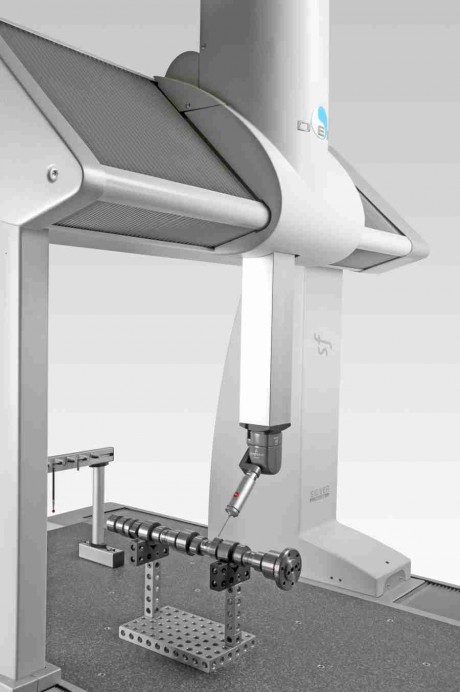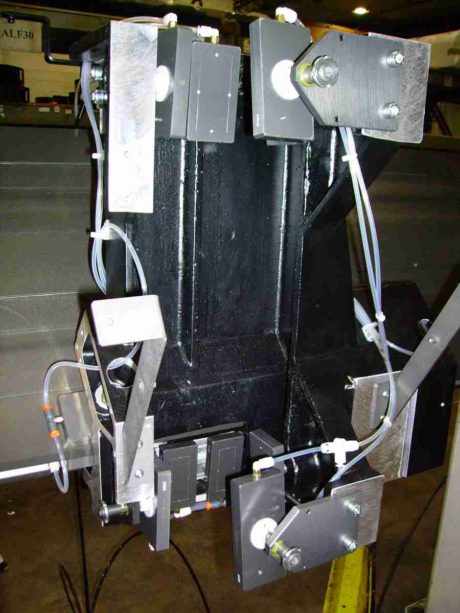Roberto Grassi –
Pneumostatic technology has recently revolutionized the way to interpret friction; the supports that use compressed air as means of subsistence are able to perform very high normal forces generating negligible frictions.
Pneumostatic systems have high costs and a remarkable air consumption that makes them convenient only for high performance equipment, the high speed servo axis and measuring machines are among the most important users of this technology. A meeting with DEA of Grugliasco (Torino, Italy), a well-known user of pneumostatic systems, has allowed to resolve some doubts on their functioning.

An innovative technology
Pneumostatic technology is still not very common and its use is limited to particular products which have a high innovative content where higher costs and air consumptions are not a problem. The use on measure machines is now consolidated because of the high precision offered by these systems. The majority of the products made by DEA is equipped with pneumostatic supports which guarantee an exceptional precision if they are used in the appropriate conditions.
Some models of DEA machines still use the traditional recirculation ball screw guide, they are cheap machines with a lower precision class and used for less prestigious applications.
Basically, a pneumostatic support is made of two parts, the actual pad and the support surface, also named contrast surface, that is the surface on which the support insists. This surface must have good finishing characteristics comparable with those obtained by grinding. Therefore, surface flatness and roughness are the two key parameters which characterize the contrast surface. Instead the pad has a slightly more complex structure. In fact, it has to contain the ducting for the distribution of supply air equally along its surface, it must host the required pneumatic connections and a ball joint which allows its rotation to compensate possible dis-alignments with the surface. The pneumostatic functioning principle (fig. 2) is based on the injection of compressed air between the pad and the surface, therefore, compressed air forms a film where there is a laminar flow and the pressure on the pad performs a force which tends to detach it from the surface.

In normal functioning conditions, the pad is lifted of about 10 micro-meters and a sort of balance is established between this value which expresses the width of the fluid meatus, the value of the air flow which draws on the edges of the pad, called load or air consumption, and the pressure below the pad, which is connected with the lifting force. The pneumostatic pad, due to the fact that there is no contact between it and the support surface, is therefore able to perform a normal force of remarkable intensity to which correspond tangential forces of negligible entity: in other words, it reduces the value of the friction coefficient to a negligible value. In theory it would not be correct to speak about friction, because there is neither a contact nor a creep, the coefficient expression of negligible friction indicates that the tangential force is a minimum fraction of the normal transmitted force. The tangential force is due to the viscous friction generated by the air meatus and, due to the minimum viscosity of air and the low speeds in play, it has a very low value. A pneumostatic pad eliminates friction but not the energy wastes connected with the creep in fact, under the energy point of view, a pad eliminates the power component lost given by the multiplication of speed and friction force while it introduces an additional energy consumption given by the load of air required for its functioning.
Therefore, the beneficial effect of a pad cannot be evaluated under an energetic point of view, but of precision; in fact, by eliminating friction, it allows obtaining high positioning precisions, eliminating a non- linear component and introducing a constant and predictable consumption.
Therefore, a pneumostatic pad behaves as a theoretical binding which zeroes a level of freedom.
In measurement machines, fluid friction is neglected, the only frictions considered are those due to cables and transmission organs. On the other hand, air consumption has always been a sensitive data, the essential need when talking about optimization of these components is to make them consume less. The very low energetic efficiency of these systems, is translated into a high capacity value of compressed air requested by the machine and consequently an increase of the company’s costs.
The installation of a pneumostatic support must follow some rules; first of all the system must be configured so that the pad can work in its best functioning conditions: fluid meatus must be set on values near 10 micro-meters (in the majority of models) or on the specific plate value for a determined pad. A pneumostatic pad should then be pre-loaded to satisfy the conditions previously exposed and the pre-loading can be obtained in various ways: by gravity and with pneumatic and magnetic contrast. The pre-load for gravity is the most immediate to obtain because the weight of the structure acts properly on the pads which are dimensioned for that load, leading them to work in their best functioning point. The pneumatic per-load, used for the greatest part of vertical movements, uses a second pad placed in such a way as to contrast the action of the main pad. The balance of the forces used by the two determines the work point.

The last type of pre-load is magnetic, and uses the attraction force of special magnets sank into the structure and which balance the force given by the pad until it sets the correct load conditions. When a pad works in the right point, it is characterized by the maximum rigidness; basically it is able to react to small movements with great variations of the value of the normal force used to re-set the system in balance. An additional peculiarity of the installation of the pads, is the compensation of imprecisions due to misalignments and tolerances of the contrast surface. This problem concerns only the pneumatic contrast methods, where in some cases it is necessary to install the contrast pad on a spring (fig. 3) able to compensate possible quota variations.
Therefore, under a structural point of view, DEA pneumostatic axes are mounted in an isostatic way using couples of pads, each one able to eliminate a grade of freedom (fig. 4). When the pads are mounted on springs and weak supports, the bindings which they generate are considered as hyperstatic due to the freedom grade related to the springs. In addition, pneumostatic compensates very well variations due to thermal gradients.
Errors and vibrations
The positioning error of a pneumostatic pad is very low; the remarkable rigidness of the pads, allows to easily bear load variations, replying with a minimum movement. Under the point of view of global rigidness, the pad is the weak element, and if a balance calculation of rigidness is performed, the structure is predominant. The dynamic effects are then absorbed for the most part by the pads and their accurate dimensioning is the basis of the stability of a pneumastatic movement system: in fact, during accelerations, the so-called load transfer phenomenon takes place, similarly to what happens on vehicles, the pad in the direction of the acceleration will be downloaded and at risk of detachment, while the pad with the increased load will risk the contact with the guide. Because of the position of the center of gravity in respect to the various sliding guides it is possible to choose the types of pad and the pre-load methods to lead the system to work in stable areas.

The rigidness of the pads, together with the remarkable masses in play, can also create very complex vibration phenomena which also interest the rigidness of the structure. The vibration of a pneumostatic system is a quite an unusual phenomenon which derives from the combination of a number of factors such as the criticality of one or more pads, meant as a work point with a too high rigidness, criticalities of the structure, and vibration modes at certain frequencies.
Safe and clean air
Pneumatic pads, due to their construction with strict tolerances, require a supply with high quality air: air must be dry and, most of all, well filtered. In order to reduce at the minimum the risk that foreign particles overlap in the thin meatus between the pad and the contrast surface, supply groups that perform a pushed filtration starting from a pre-filter of 5 micron followed by one or more 2 micron filters, are used. Another problem is given by residual humidity of the air: this must be eliminated in order to avoid the forming of condensation which could block the thin supply holes. If filtration is performed inside the machine, humidity should be eliminated by the customer; in fact, measuring machines do not contain a drying device but have strict specifications about air humidity in entrance. The supply pressure required to make the pads properly work, is now of about 4 bars which arrives to 6 to compensate the losses in the filters. The old measuring machines equipped with very big pads, required 8 bars and for their supply specific compressors were installed. Supply compressed air is a critical parameter, a sudden interruption could lead to serious consequences on the structure and the pads; if the breakage is detected by the control system in time, the axes are immediately stopped and the damage is limited but it is always dependent on the inertia of the mobile part. The sudden stop of an axis in movement equipped with a consistent inertia, although it is an uncommon event, in most cases causes a dry creep of the pad on the support surface. The granite guides which equip the majority of modern measurement machines, resist very well to the damaging because the weakest material is always that of the pad; therefore, the pad loosens and slightly wears out. It is not unusual that a pad can survive a dry run of a small entity without having to replace it.
Acknowledgements
The author would like to thank Dr. L. Merlo of Hexagon and Dr. G. Mang of Mager for their patient training on pneumostatic components.
Hexagon Metrology
The DEA brand originates from the industrial reality of the Piemonte Region; founded in Moncalieri and then transferred to the headquarters of Grugliasco, it was acquired by the Hexagon group, a multi-national company specialized in measuring equipment which also controls other brands such as LEICA Geosystem and Leitz, specialized in highly precision machines for metrology (www.hexagonmetrology.it).
Pneumostatic technology is used by all the companies of the Hexagon group and the pneumostatic products for the made in Italy machines are supplied by Mager in Cambiano (Turin , Italy), Italian and worldwide leader in the production of compressed air supports. (www.mager-ab.it).



